21st-century works in The New York City Ballet’s Winter season (January 23-March 4)
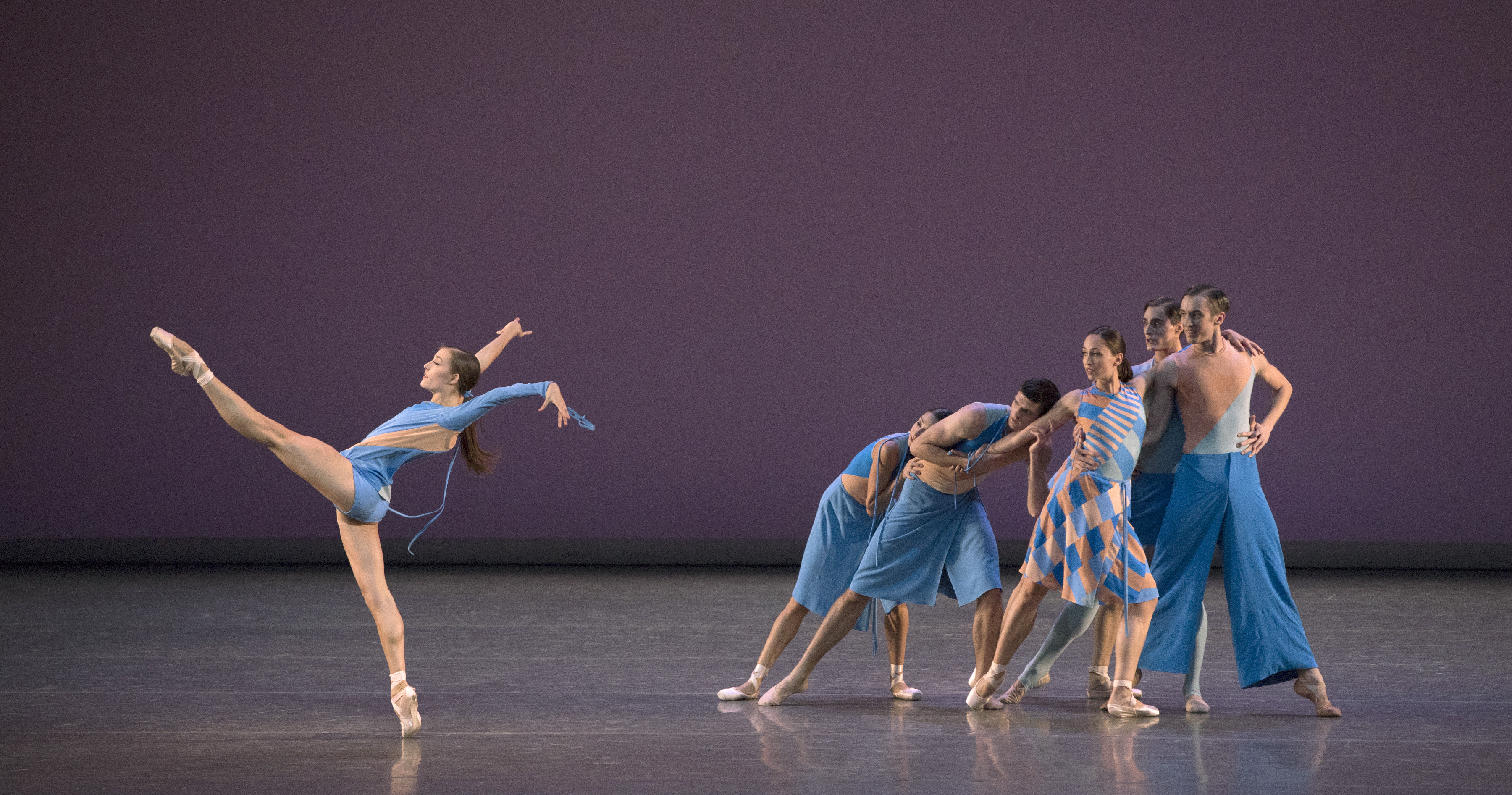
Mimi Staker (L) and members of the New York City Ballet in Troy Schumacher’s The Wind Still Brings. Photo: Paul Kolnik
A subtle artistic schism exists for dancers in the New York City Ballet. None of them knew its co-founder Balanchine. They hadn’t taken his classes; they hadn’t watched him choreograph new ballets or lent him their bodies to use as inspiration and building blocks. If they experienced ballets by his later colleague Jerome Robbins from the inside out, they would have been very young at the time; his last ballet, Brandenburg, premiered in 1997, a year before his death. The new works in which they were cast were choreographed by the company’s (now-former) ballet master in chief Peter Martins, by guest choreographers, or by fellow dancers.
These are exemplary dancers. Given roles in Balanchine masterpieces, they rise to the occasion. Why, for example, wouldn’t current principal dancer Chase Finley have been thrilled to perform the title part in Balanchine’s 1928 Apollo, following Lew Christensen (the first American Apollo), Jacques d’Amboise, Peter Martins, Peter Boal, Sean Lavery, and Nilas Martins (am I forgetting someone?). But it’s my impression that NYCB members especially love the challenge of being material for unfamiliar dancemakers, as well as supporting colleagues in the company who have the urge to choreograph.
The program I saw last week (one of those labeled “21st-Century Choreographers”) consisted of The Wind Still Brings by Troy Schumacher, Composer’s Holiday by Gianna Reisen, Angelin Prelocaj’s Spectral Evidence, and Justin Peck’s Year of the Rabbit. I’d seen the first two ballets when they premiered this past September at the NYCB’s Gala. Schumacher’s ballet is the third one he has made for NYCB, where he is a soloist (he has choreographed others for his own BalletCollective). Composer’s Holiday is Reisen’s first work for NYCB; an apprentice with Ballet Semioper Dresden, she participated twice in the New York company’s Choreographic Institute. Year of the Rabbit is the second piece that Peck made for NYCB, back in 2012, while still in the corps de ballet; in 2014, by then a soloist, he became the company’s resident choreographer. Preljocaj has headed his own group in Aix-en-Provence since 1996, and his 2013 work shows the company dancers in a very different light from anything Balanchine or Robbins might have dreamed up.
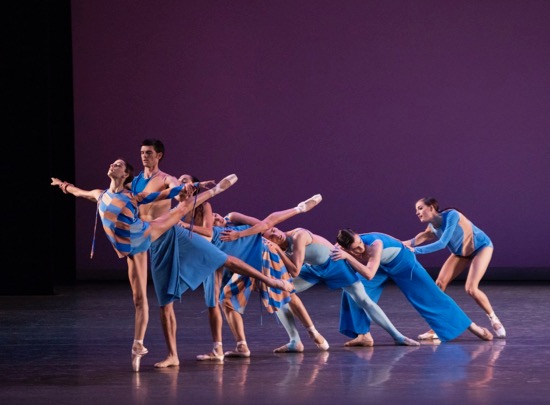
Eliza Blutt and Peter Walker head the line in Troy Schumacher’s The Wind Still Brings. Photo: Paul Kolnik
The fourteen dancers in Schumacher’s piece are all members of the corps de ballet. Jonathan Saunders’ bold blue, or blue and orange, costumes play games with gender. The tallest man (Peter Walker) wears a sarong; a ring-leader woman (Claire Kretzschmar) sports long, full pants. The Wind Still Brings may be an enigmatic title, but it’s an apt one. In its opening and closing allegro movements (drawn from William Walton’s Piano Quartet in D minor and arranged for orchestra by Robert Miller), the dancers indeed seem to be blown by contrary winds, whether they race together and apart or travel as a cluster. When a man supports a woman in arabesque, others attach themselves to him like leaves blown against an obstacle (only more orderly).
The last movement strikes me as having almost too many ideas in it. It certainly seems so in contrast to the second section, set to Walton’s “Andante tranquillo.” Schumacher has built most of the choreography around a single set of actions. With almost all the dancers supine, a woman enters with a flutter of tiny steps on pointe and initiates a general awakening. She touches the rib cage of a fallen colleague, who arches in response, as if taking a huge breath. Then she lies briefly beside the woman, and some kind of transmission of energy takes place. Once both are on their feet, the two press their cheeks into each other’s necks, then separate to awaken others, who in turn minister to still more. Schumacher gives us a lot of time to think about the gradually swelling design.
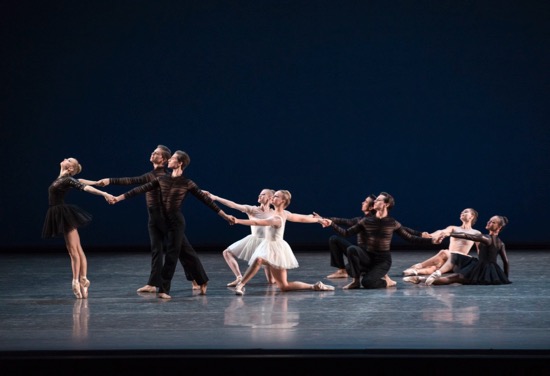
Emma Von Enck leads a chain in Composer’s Holiday by Gianna Reisen. Photo: Paul Kolnik
Reisen’s Composer’s Holiday is set to Lukas Foss’s Three American Pieces for Violin and Piano and takes its title from the last of the work’s three sections. Pianist Susan Walters and violinist Arturo Delmoni play the score from the left front edge of stage. The elegant costumes by Virgil Abloh of Off-White™ for the twelve are either black or white or faintly pink. The music is sweet, playful, at times gently jazzy, but its spare beginning suits the enigmatic image you see when the curtain goes up: men hold a collapsed woman overhead, while each of four women sitting together on the floor raises an arm toward the tableau as if to hail it.
Reisen was 18 years old when she made this ballet last September. Of the two principal men in it, Gilbert Bolden III is an apprentice in the company, and Roman Mejia (son of former company dancer Paul Mejia), who was an apprentice at the time, is now a member of the corps de ballet. Their partners, Christina Clark and Emma Von Enck ended their apprenticeship and entered the company in August. So, a young cast performing with as much assurance as company veterans.
The piece has a dreamlike incoherence at times. The first section ends with Von Enck slowly walking toward the audience atop a traveling cluster of colleagues; suddenly, they throw her into the air and Mark Stanley’s lights go out before she falls. When the second section begins, one man, lying alone onstage, wakes up. A pas de deux ends with Clark crawling offstage hanging onto Bolden as he strides along.
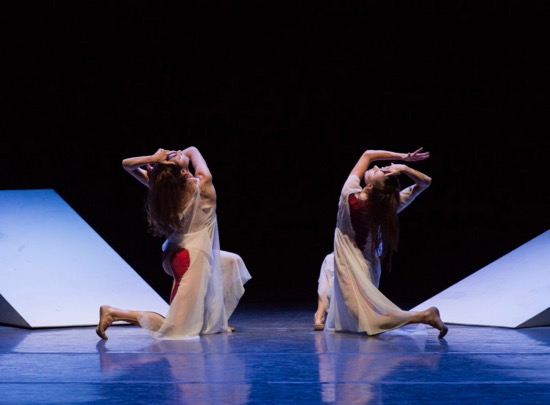
Two New York City Ballet “specters” in Spectral Evidence by Angelin Preljocaj. Photo: Paul Kolnik
If Reisen’s ballet suggests a dream, Preljocaj’s is pure nightmare. He must have chosen the five richly varied pieces of recorded music by John Cage for their eerie possibilities. At one tortured point, Amar Ramasar opens his mouth to lip-synch a few sung words that surface from the Cagean depths. Once, Sean Suozzi utters a silent howl. The “spectral evidence” that gave the ballet its title alludes to the days of the Salem witch trials; if someone dreamed of diabolical behavior by a community member, the dreamed-of person could be suspected of witchery.
Preljocaj formalized this in hair-raising theatrical ways, abetted by a set of angular white shapes that, pressed together, could suggest a “Last Supper” table and, when pulled apart by the cast, could create inclines for Tiler Peck, Megan Fairchild, Ashly Isaacs, and Megan LeCrone to be slid down and pulled back up. Fully separated and stood on end, the parts of the set become individual coffins. Oliver Theyskens’ filmy costumes for the women (like all garb on the program, supervised by Marc Happel) have stiff, blood-red patches stuck to them. And, true to the title, the women materialize, each of them from behind one of the black-clad men with slicked-down hair sitting on the table (Ramasar, Chase Finlay, Taylor Stanley, and Suozzi). We glimpse the ghostly women’s arms creep around the men before we see the rest of them. In one alarming illusion, the men are bent back over the table, so that the women standing behind each of them appear to be hermaphroditic: a woman’s face, wild hair, and flowing white sleeves ends in sprawling, black-trousered legs.
The men are affected by their dreams—beautiful creatures who run their hands down the puritanical male bodies. Once stiff and correct, their dancing scything the air, these guys can lounge indolently or embrace—kiss—these dreamed-of women or struggle against temptation. Ramasar and Tiler Peck have a benighted duet that expresses his fascination with what he has conjured up. In the end, the women disappear behind the set in a flash, as if exploding with the coming of dawn.
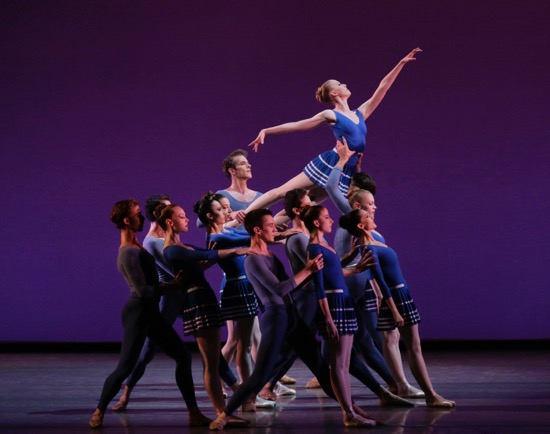
Teresa Reichlen aloft in Justin Peck’s Year of the Rabbit. Photo: Paul Kolnik
These NYCB programs labeled “21st Century Choreographers” give the audience its second glimpse of the company’s principal dancers. In Peck’s Year of the Rabbit, we see five of them, plus soloist Indiana Woodward, heading a corps of 12, whose members appear in various combinations. Peck was 25 when the ballet premiered, and this was the first time I’d seen it. As is often the case, watching a dance, succumbing to it, you’re hard put to articulate what’s making it shine. In Year of the Rabbit, classical steps look completely fresh, organized in slightly unusual ways that nevertheless don’t call attention to themselves as feats.
Impudent allusions, however, do arise. At one point, in an upstage corner, clustered dancers lean over and stack their heads on top of one another in a single vertical line, and if you’ve ever seen a photo of Bronislava Nijinska’s 1923 Les Noces or a reconstruction of it, that reference pops into your mind. In the first of seven sections, Ashley Bouder, standing on one leg and leaning forward, keeps brushing her other foot up behind it. It’s almost a cliché; she’s stuck in place, rarin’ to go.
The ballet’s parenthetical subtitle is “Selections from the Chinese Zodiac.” Peck’s selections, in addition to the rabbit, are Ox, Tiger, Dragon, Rooster, Boar, and an interloper: “Year of Our Lord” (a slow, sustained duet for Woodward and Taylor Stanley). The score was composed by Sufjan Stevens and orchestrated by Michael P. Atkinson. Neither the choreography nor the costumes (designed by Peck) make obvious references to a particular animal (although Bouder’s pawing does happen in “Year of the Ox”). The men all wear gray leotards and deep blue tights. The women’s matching blue leotards are enhanced by short skirts with white piping.
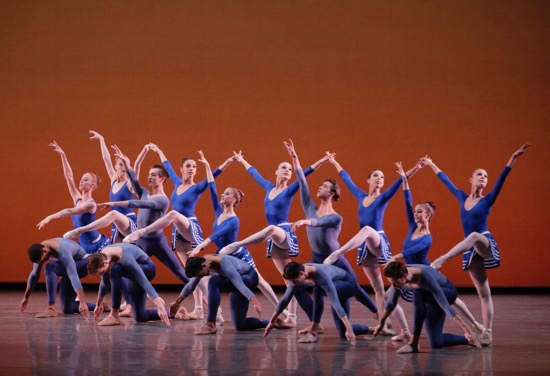
Fifteen New York City Ballet dancers create a living hedge in Justin Peck’s Year of the Rabbit. Photo: Paul Kolnik
Peck engages both corps and soloists in resourceful ways. When Bouder is stage right, being sprightly and tricky with her feet, she is faced down by a network of colleagues: three principal dancers augment the corps of twelve to form three stationary diagonal lines of five, each line with its own movement pattern. A dense, changeable fence.
One memorable solo, “Year of the Rabbit,” is performed by Anthony Huxley, who is as fast on his feet as the titular mammal. Peck has created a wonderfully buoyant bag of tricks for him, and when he’s tired, he can sit and watch the women slide into splits, and the men lie down. Amid this, Teresa Reichlen and Jared Angle arrive for “Year of the Tiger.” The others treat them like the stars they are; at one point, four women, bending low, surround him, while four men encircle her. The cast is busy in every section. They seem to have errands offstage, but various of them need to return. And formality isn’t always the rule. At the end of another duet for Reichlen and Angle (“Year of the Rooster”), the two stop and look around, as if to say, “Where did everyone go?” And, “Which way should we go?”
The latter may be a question many people are asking these days about the New York City Ballet. After nearly thirty years as the company’s ballet master in chief, Peter Martins resigned on January 1 in response to reports of his physical and mental abuse of dancers (charges that he has denied). While the search for a replacement is going on, an Interim Artistic Team is leading the NYCB; it consists of four former company dancers, three of whom are now ballet masters: Craig Hall, Rebecca Krohn, Jonathan Stafford. The fourth member of the team is Peck.
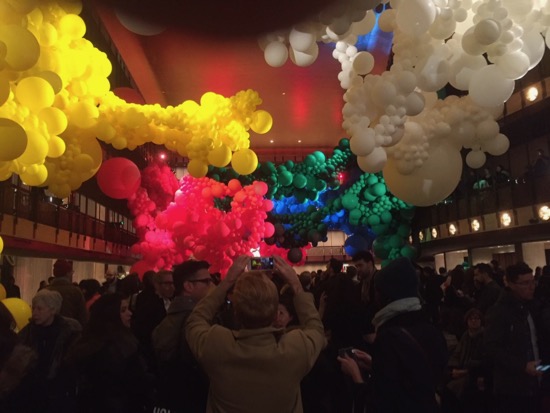
Spectators mingle and raise their phones to capture Jihan Zencirli’s floating lobby installation.
The questions and issues floating around the New York City Ballet’s future may be heavy ones, but the installation filling the grand tier lobby of the theater that Philip Johnson designed provides a lesson in buoyancy (with free drinks after this particular performance adding to it). People walk around and beneath Jihan Zencirli’s jungle of balloons—thousands of them. Said to be biodegradable and compostable, these range from about ten inches to ten feet in diameter, and are currently grouped by color, with the white and black ones taking over one end of the space. Do Elie Nadelman’s giant, blobby white statues of heroic figures, stuck there since 1964, feel uplifted by them or threatened? Hard to say. Welcome to 2018.

Can’t resist answering the Apollo question, Deborah, and you left out Baryshnikov, which I have on dvd. It wasn’t his role and I once had a discussion of why not with Christopher Stowell when the latter was directing Oregon Ballet Theatre and his analysis made some sense: Baryshnikov was already a star, projecting a fledgling god was something he couldn’t do. Suspect a couple of years later he could have, star or not, because he really is an extraordinary actor.
Beyond that, thank you as usual for putting me in the theater with you. I have liked Preljocaj’s work in the past, particularly an early work called Le Parc, not sure I would have warmed to this one. Year of the Rabbit is something I would dearly love to see and Composer’s Holiday looks interesting.
Leaving out Baryshnikov isn’t easy! Strange to say, I blanked out his year (1978) of dancing in the NYCB.
Well, it was only a year after all. What I think he danced supremely well there was Prodigal Son. At least on film, he made me understand the meaning of the word plastique.
More Apollos: Andre Eglevsky was the first NYCB Apollo (I never saw him in this role) but he was soon followed by Jacques d’Amboise , whom I, and no doubt countless others ,still consider the greatest NYCB interpreter of this role. Off the top of my head I remember Conrad Ludlow, most memorably because during a performance of the complete ballet he became entangled in his swaddling cloths, which are supposed to unwind as the newly-born god executes a powerful , multi-turn pirouette.
I look forward to seeing many of these new and recently done pieces. I’d like to point out one thing that has disturbed me. The company’s scheduling of recent seasons. Balanchine and Robbins have mostly been segregated from the other repertory in “All Balanchine” and “All Robbins” programs. (And the newer pieces segregated as well.) I would love to see both Balanchine and Robbins represented in programs that include more recent pieces. It just seems to indicate that these ballets are being pushed into a corner, when I think they would enhance the newer pieces, and vice versa. There are so many combinations possible! Scheduling and programming are difficult, admittedly; it seems, however, that NYCB could use some imagination in this area.
Thank you for your comment, Mary. I wonder if surveys and experience have influenced those who program the seasons these days.
Perhaps they know which ballets appeal to a particular demographic?
Susan Reiter just e-mailed me this message: “Since you asked — I would add Ib Andersen to the list of distinguished NYCB interpreters of Apollo.” Indeed!
Mary Sheehan’s point is well taken. I am looking forward to one of this season’s NYCB programs because it is, for once, a true representative combination. Balanchine’s “Square Dance” opens, followed “Oltremare, a 2008 work for the company by Mauro Bigonzetti, and it closes with Robbins’ “The Four Seasons.” I do hope we see more programs along those lines.